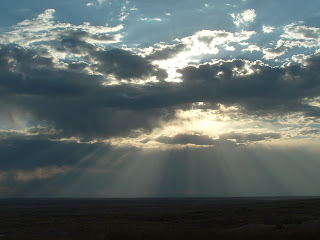Still life with basil: last year's haul of wild plums
But canning can't wait forever. The produce season up here is short, and it is coming to an end. So many things are happening simultaneously: new building, new semester, new course to teach, family in town....and more canning. I am hoping that we get another bumper crop of wild plums and apples this year. In the meantime, we are finding treasures at the farmers' market. Best find yesterday: the first of the year's pears and perfectly ripe raspberries, which will make a pie or cobbler to feed the aforesaid visiting family.
Here are some recipes for herb jellies. The herbs are coming in, too, and these make sweet and savory jellies with pure gem colors. The possible combinations are endless. If you've got others, please share them. I don't worry too much about the food coloring unless the jelly looks off-putting. It all tastes wonderful.
Mint jelly
6 lb. apples, stemmed and chopped
6 cups water
3 cups sugar
¾ cup fresh mint leaves, crushed
2 T lemon juice
2 drops green food coloring
Combine apples and water in a large Dutch oven; bring to a boil. Cover, reduce heat, and simmer 20 to 25 minutes. Strain apples through a jelly bag or 4 layers of cheesecloth, reserving 4 cups juice. Discard pulp. Combine reserved juice, sugar, mint, lemon juice and food coloring in Dutch oven. Bring to a rolling boil, stirring frequently. Boil until mixture reaches 220* F on candy thermometer. Remove from heat and skim off foam. Quickly pour jelly through a sieve into hot sterilized jars, leaving ¼ ” headspace. Cover at once with metal lids and screw bands tight. Process in boiling-water bath for 5 minutes. Yield: 4 half-pints.
Note: If you don't normally use a candy thermometer, it's a good time to learn how to do so, unless you prefer uncooked freezer jams. Jellues need to be cooked and clarified, and can be very touchy.
Basil jelly
6 lb. apples, stemmed and chopped
6 cups water
3 cups sugar
2 T chopped fresh basil leaves
2 T lemon juice
Follow directions as for mint jelly (above), substituting coarsely chopped basil and omitting food coloring.
Rose geranium jelly
4 cups apple juice
8 drops red food coloring
1 1¾ oz. pkg. powdered fruit pectin
5-½ cups sugar
7 fresh rose geranium leaves
Combine juice, food coloring and pectin in a large Dutch oven. Quickly bring to a rolling boil, stirring frequently. Add sugar and return to a rolling boil, stirring constantly. Boil 1 minute, stirring. Remove from heat and skim off foam. Place 1 rose geranium leaf in each of 7 hot sterilized half-pint jars. Quickly pour jelly into jars, leaving ¼ ” headspace. Cover at once with metal lids and screw bands tight. Process in boiling-water bath 5 minutes.
You can use this one with any of the "flavored" geraniums.
Rosemary jelly
1 ½ cups white grape juice
8 drops red food coloring
½ cup water
8 drops yellow food coloring
3-½ cups sugar
3 T fresh rosemary leaves, crushed
1 3-oz. pkg. liquid fruit pectin
Combine all ingredients except pectin in a large Dutch oven. Quickly bring to a rolling boil, stirring constantly. Cook 1 minute, stirring. Add pectin and cook, stirring constantly, until mixture returns to a rolling boil. Continue boiling 1 minute, stirring. Remove from heat and skim off foam. Quickly pour jelly through a sieve into 4 hot sterilized half-pint jars, leaving ¼ ” headspace. Cover at once with metal lids and screw bands tight. Process in boiling-water bath 5 minutes.
Sage jelly
1 ½ cups apple cider
¼ cup chopped fresh sage leaves
½ cup water
6 drops yellow food coloring
3-½ cups sugar
1 3-oz pkg. liquid fruit pectin
Follow directions as for rosemary jelly (above), substituting coarsely chopped fresh sage leaves.
Thyme jelly
1 ½ cups white grape juice
3 T fresh thyme leaves, crushed
½ cup water
8 drops red food coloring
3-½ cups sugar
1 3-oz pkg. liquid fruit pectin
Follow directions as for rosemary jelly (above), substituting crushed fresh thyme leaves.
Herb-juice jellies
2 T dried herbs
3 cups juice
6 cups sugar
1 bottle liquid pectin
Combine dried herbs and juice. Bring to a boil. Remove from heat and let steep 10-15 minutes. Strain and add water to make 3 cups. Add sugar and bring to a full rolling boil. Cool one minute. Add pectin and return to hard rolling boil. Pour jelly into sterilized jars and seal immediately. Makes approximately 8 half-pints.
Juice-herb combinations
Orange-marjoram
Tomato-lemon thyme
Pineapple-mint
Grapefruit-rosemary
Grape-sage
Boysenberry-thyme
Lime-tarragon
Apple-sage
Apple-rose geranium
Beet-ginger
Lemon-parsley
Happy Monday. Save everything you can.
P.S. for those who asked: we kept the kitten.










































.JPG)

.JPG)
.JPG)



.JPG)
.JPG)
.JPG)
.JPG)
.JPG)
